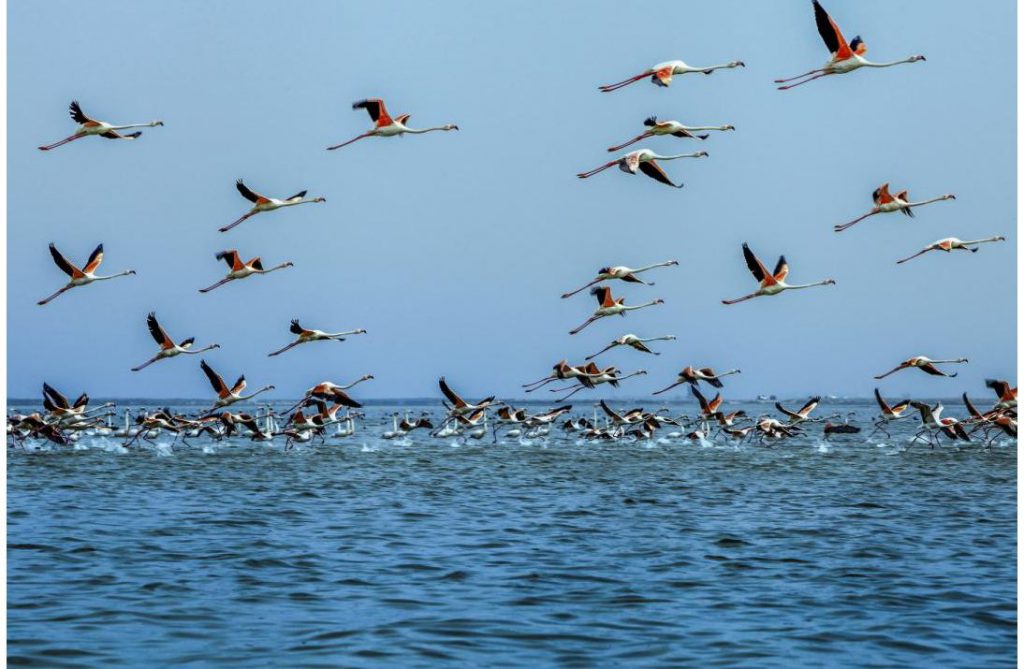
Akyatan Lake YHGS
Tag
City: Adana
Area (ha): 15291.11
Announcement Date: 16.10.2005
General features
Biodiversity
Flora: The influence of Turkish-Iranian and Mediterranean plant geography is dominant in the region. The diversity of living environments has allowed the development of plant species with different ecological demands. The most interesting part in terms of plants is the dunes located between the sea and the lagoons. As you go from the lagoons to the dunes, oleander and hedgehog thistle are seen as the dominant species. Further inland, broomrape, mouse ear, vetch and clover are common. The bushes are composed of myrtle, blackberry and Smilax species. In areas where fresh water is effective, there are sedge, reed, water lily and yellow iris.
Afforestation works were started in 1955 for the purpose of sand dune stabilization and approximately 3687 hectares of dune area has been afforested to date. Eucalyptus, , acacia, pine, and cypress were used in afforestation.
Fauna: Living environments with different ecological characteristics such as open water surfaces, reeds, fresh and salty marshes, fresh water ponds, ponds, wide dune ecosystems, beaches provide the shelter of a very rich wildlife from different species, especially waterfowl.
The wide sand dunes and bushes between the lake and the sea are very suitable habitats for many mammals from the carnivorous order. The most common appearing species in the field is the coyote. Other species appearing in the area; fox, wild cat, rabbit and hedgehog. Tail riding is common on lake shores and in places where small lakes formed by old river branches exist. Otters have also been spotted in the area.
The region is richly diversified in terms of wetland habitats, with abundant tree frogs, lowland frogs and nocturnal frogs. The important species in the region, which is also very rich in terms of shoots, are the green turtle and the common sea turtle. The beaches in the region are one of the few important breeding grounds of Chelonia mydas in the Mediterranean. To the striped turtle and swamp turtle in freshwater ponds and channels; On the other hand, tortoises are frequently encountered in the dunes. Deep-headed snake, arrow snake, eel-eye lizard, chunky lizard, chameleon, Crytodactylus kotschyii and Agama stellio are other reptile species seen in dunes.
Akyatan Lake is one of the important fisheries in the Mediterranean. Due to its connection with the sea, plenty of fish enter the lake to feed. The other important species in the lake is the blue crab.
The most important fauna elements taken are waterfowl. Akyatan Lake is one of the wetlands of international importance in our country, according to international criteria. Being on the migration route, diversity of living environments and suitable climatic conditions have made the area rich and important in terms of bird existence.
In a survey conducted in March, April and May 1990, 250 bird species were identified in the area. Thousands of shorebirds stay in the lake during migration. The mud flats around the lake are ideal environments for shorebirds. Coastal birds forming crowded groups during migration; swordbill, small plover, small sandpiper, martial bird and snipe.
The reedy shores and bush-covered dunes of the lake, which is extremely rich in insects, are ideal feeding and sheltering areas for birds such as hoopoe, rainbow raven and swallow.
Akyatan Lake is extremely important as a wintering area. Especially in periods when severe cold dominates Anatolia, bird existence in the area reaches great numbers with the freezing of the lakes in the Anatolian plateau. Between 70,000 and 80,000 waterfowl spend the winter in the area each year.
In addition , common pochard, Eurasian wigeon , common shelduck and Eurasian coot form large groups in the area. One of the important species that overwinter in the lake is the flamingo. Every year, more than 10,000 flamingos, most of which come from Iran’s Lake Urmia, spend the winter in the lake.
The area is notable for breeding populations of summer ducks, francolins, reed roosters, bigeye, maple plover, spur lapwing, and little tern. It is home to a large number of waterbirds, the most important of which are the flamingo, common shelduck, Eurasian wigeon, common pochard, duckbill and Eurasian coot. Akyatan is of great importance for shorebirds, such as pied avocet, plover and sandpiper.
The sand dunes between Lake Akyatan and the sea are the habitat of various species of small passerines during their breeding and immigrantperiods. While the kingfisher breeds in the region, the pied kingfisher is mostly seen during the winter months.
